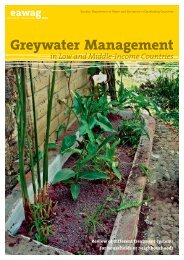Household Water Treatment and Safe Storage Factsheet: Source ...
Household Water Treatment and Safe Storage Factsheet: Source ...
Household Water Treatment and Safe Storage Factsheet: Source ...
You also want an ePaper? Increase the reach of your titles
YUMPU automatically turns print PDFs into web optimized ePapers that Google loves.
<strong>Household</strong> <strong>Water</strong> <strong>Treatment</strong> for Fluoride Removal<br />
<strong>Factsheet</strong>: Activated Alumina Filter<br />
Potential <strong>Treatment</strong> Capacity<br />
Very Effective For: Somewhat Effective For: Not Effective For:<br />
Fluoride<br />
Arsenic<br />
Turbidity<br />
Taste, odour, colour<br />
Bacteria<br />
Viruses<br />
Protozoa<br />
Helminths<br />
Hardness<br />
What Is Activated Alumina Filter?<br />
Activated alumina, also called aluminium oxide<br />
(Al 2 O 3 ) granular, is one of the most widely<br />
used materials for the removal of chemicals<br />
from water. This highly porous material is<br />
prepared by low temperature (300-600°C)<br />
dehydration of aluminium hydroxides.<br />
Activated alumina grains are packed in a filter<br />
like s<strong>and</strong>. When water passes through it,<br />
certain contaminants in the water adsorb<br />
(stick) to the activated alumina. Activated<br />
alumina removes fluoride from water, <strong>and</strong> can<br />
also be used for arsenic removal (see the<br />
corresponding Arsenic Removal by Adsorption<br />
factsheet).<br />
How Does It Remove Contamination?<br />
Fluoride is removed from water through an<br />
exchange reaction at the surface of the<br />
activated alumina. Fluoride adsorbs to the<br />
alumina more easily than other molecules in<br />
water. This results in high defluoridation<br />
capacity.<br />
According to laboratory tests, the fluoride<br />
removal capacity of alumina is between 4 <strong>and</strong><br />
15mg of fluoride per gram alumina (Hao <strong>and</strong><br />
Huang, 1986). However, field experience<br />
shows that the removal capacity is often about<br />
1mg/g (COWI, 1998). The treatment capacity<br />
also depends on the specific grade (quality) of<br />
activated alumina, the particle size <strong>and</strong> the<br />
water chemistry (pH, alkalinity <strong>and</strong> fluoride<br />
concentrations).<br />
The optimum dosage of activated alumina for a<br />
particular source water needs to be<br />
determined by conducting a jar test<br />
experiment.<br />
Activated Alumina-based <strong>Household</strong> Defluoridation<br />
Operation<br />
(Credit: Lyengar, 2002)<br />
There are different kinds of activated alumina<br />
filters. One of them consists of two containers<br />
(see above diagram). The upper container<br />
holds the activated alumina (3 kg, depth of 17<br />
cm, Lyengar 2002). The top of this container<br />
can be covered with a perforated stainless<br />
steel disc to avoid disturbing the media when<br />
water is poured in. It should also be covered<br />
by a lid. The lower container can be any kind<br />
of bucket or pot with tap, used for storing the<br />
treated water.
















